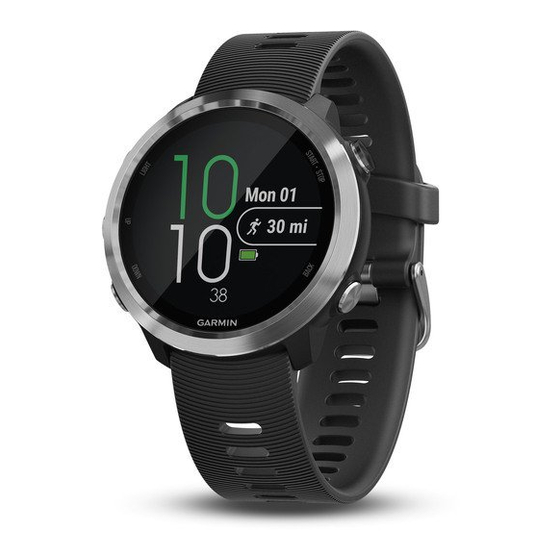Garmin FORERUNNER 645 MUSIC Руководство пользователя - Страница 14
Просмотреть онлайн или скачать pdf Руководство пользователя для Смотреть Garmin FORERUNNER 645 MUSIC. Garmin FORERUNNER 645 MUSIC 38 страниц.

runners. More experienced runners tend to exhibit shorter ground contact times, lower vertical oscillation, lower vertical ratio, and
higher cadence than less experienced runners. However, taller runners typically have slightly slower cadences, longer strides, and
slightly higher vertical oscillation. Vertical ratio is your vertical oscillation divided by stride length. It is not correlated with height.
Go to
www.garmin.com/runningdynamics
running dynamics data, you can search reputable running publications and websites.
Color Zone Percentile in Zone Cadence Range Ground Contact Time Range
Purple
>95
Blue
70–95
Green
30–69
Orange 5–29
Red
<5
Ground Contact Time Balance Data
Ground contact time balance measures your running symmetry and appears as a percentage of your total ground contact time. For
example, 51.3% with an arrow pointing left indicates the runner is spending more time on the ground when on the left foot. If your
data screen displays both numbers, for example 48–52, 48% is the left foot and 52% is the right foot.
Color Zone
Symmetry
Percent of Other Runners
Ground Contact Time Balance >52.2% L 50.8–52.2% L 50.7% L–50.7% R 50.8–52.2% R >52.2% R
While developing and testing running dynamics, the Garmin team found correlations between injuries and greater imbalances with
certain runners. For many runners, ground contact time balance tends to deviate further from 50–50 when running up or down hills.
Most running coaches agree that a symmetrical running form is good. Elite runners tend to have quick and balanced strides.
You can watch the color gauge or data field during your run or view the summary on your Garmin Connect account after your run.
As with the other running dynamics data, ground contact time balance is a quantitative measurement to help you learn about your
running form.
Vertical Oscillation and Vertical Ratio Data
The data ranges for vertical oscillation and vertical ratio are slightly different depending on the sensor and whether it is positioned at
the chest (HRM-Tri or HRM-Run accessories) or at the waist (Running Dynamics Pod accessory).
Color Zone Percentile in Zone Vertical Oscillation Range at
Purple
>95
Blue
70–95
Green
30–69
Orange 5–29
Red
<5
Tips for Missing Running Dynamics Data
If running dynamics data does not appear, you can try these
tips.
• Make sure you have a running dynamics accessory, such as
the HRM-Run accessory.
Accessories with running dynamics have
module.
• Pair the running dynamics accessory with your Forerunner
device again, according to the instructions.
• If the running dynamics data display shows only zeros, make
sure the accessory is worn right-side up.
NOTE: Ground contact time and balance appears only while
running. It is not calculated while walking.
Performance Measurements
These performance measurements are estimates that can help
you track and understand your training activities and race
performances. The measurements require a few activities using
wrist-based heart rate or a compatible chest heart rate monitor.
These estimates are provided and supported by Firstbeat. For
more information, go to www.garmin.com/physio.
10
for more information on running dynamics. For additional theories and interpretations of
>183 spm
<218 ms
174–183 spm
218–248 ms
164–173 spm
249–277 ms
153–163 spm
278–308 ms
<153 spm
>308 ms
Red
Orange
Poor
Fair
Good
5%
25%
40%
Chest
<6.4 cm
6.4–8.1 cm
8.2–9.7 cm
9.8–11.5 cm
>11.5 cm
on the front of the
Green
Orange
Fair
25%
Vertical Oscillation Range at
Waist
<6.8 cm
6.8–8.9 cm
9.0–10.9 cm
11.0–13.0 cm
>13.0 cm
NOTE: The estimates may seem inaccurate at first. The device
requires you to complete a few activities to learn about your
performance.
Training status: Training status shows you how your training
affects your fitness and performance. Your training status is
based on changes to your training load and VO2 max. over
an extended time period.
VO2 max.: VO2 max. is the maximum volume of oxygen (in
milliliters) you can consume per minute per kilogram of body
weight at your maximum performance.
Recovery time: The recovery time displays how much time
remains before you are fully recovered and ready for the next
hard workout.
Training load: Training load is the sum of your excess post-
exercise oxygen consumption (EPOC) over the last 7 days.
Red
Poor
5%
Vertical Ratio at Chest Vertical Ratio at Waist
<6.1%
6.1–7.4%
7.5–8.6%
8.7–10.1%
>10.1%
<6.5%
6.5–8.3%
8.4–10.0%
10.1–11.9%
>11.9%
Heart Rate Features
